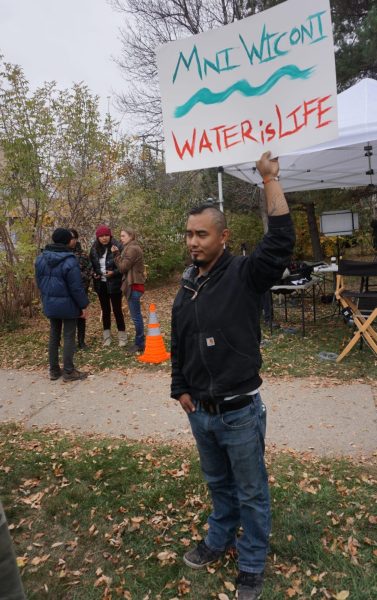Jun 26, 2024

You recently returned from protesting the Dakota Access Pipeline. Tell us about the time that you spent in Standing Rock.
Warren, my baby brother, was there at my side most the time. I was introduced to Standing Rock with the canoe paddle in September. My family and about fourteen others took the canoe over. There were eight other traditional canoes from all over the United States. The reception we received was unforgettable and made a big impression on me.
Where did you stay while you were there and being that it was the middle of winter how did you stay warm?
We all camped. There were three main camps that had anywhere from 1,000 to 10,000 people in them. Local tribes were very well represented. We heard some people were saying that the large number of people in the camps was bad for the environment, but we all did an amazing job with the cleanup, before the bulldozers arrived and tore everything to pieces. We made composting toilets while we were there.
Staying warm wasn’t always easy. The temperature got down to -40 F. My upbringing—learning the right way to start and tend a fire and how to keep warm when you’re hunting in freezing weather—really helped me. Staying hydrated was important. Unless water was near a heat source, it froze and that caused a lot of people to be dehydrated.
Where does the pipeline project currently stand?
I believe it’s in Iowa now. All the work in North Dakota is done.
What does that mean for the people of the Standing Rock Sioux Reservation?
The pipeline goes through their reservation. If the pipeline did break it would mean 18 million people’s drinking water would be at risk.
On the news we all saw video and reports of violence in Standing Rock. Did you witness any aggressive acts on either side?
I did see violence in Standing Rock. I’d say it was mainly based on ignorance from both sides. There were protesters who egged on the officers and that wasn’t needed. On the other side, there were officers—green officers mostly—who weren’t ready for that many people and also weren’t prepared to be out in the cold for as long as they were. I think that caused some of the violence.
For those Kalispel members who are concerned about the events that took place at Standing Rock, what can he or she do to show their support?
There is a movement called the “wake-up tour” that got started at Standing Rock. Water Protectors are a group of people who travel around the country protesting developments that put clean water at risk. These people live a nomadic lifestyle and sometimes need a place to stay if they are traveling through the area. Anyone interested could contact me if they wanted to help out.
Our current president has shown his support for the pipeline. Based on your experiences in Standing Rock what would you say to him?
Well, under the prior president we had won. I’d say the current president doesn’t know what he’s getting himself into and needs to reflect on his actions.
Is there anything you want to add or would like Kalispel members to know about your experience at Standing Rock?
The children (teenagers) who started this movement stayed until the very end. The girl who first went to Washington DC stayed until the camps were closed. She was in the kitchen cooking for everyone when the camps were raided or evacuated—depending on what you want to call it. The children never stopped fighting. That’s what kept me there: I was there to help protect the kids. They are the whole point of the protest. Our children have to have clean water to drink when they’re older.
